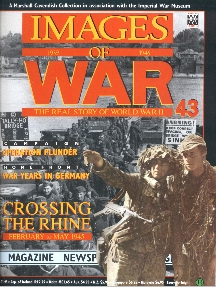This is a background account, leading up to the bombing of Wesel on 23rd March 1945, in which my father took part and is taken from the series " Images of War."
He was flying one of the 212 Lancaster bombers mentioned below
After fighting their way across the whole of Western Europe, the Allies are now poised to take the final obstacle and beat the Germans on their home soil.
Across the Rhine.
….. Meanwhile, the Anglo-American assault troops - the 15th Scottish and 51st Highland Division, plus 1st Commando Brigade in the British Second Army, and the 30th and 79th Infantry Division in the US Ninth - moved up to their start lines, hidden from enemy view by an enormous smoke screen. At 3.30 pm on 23rd March 1945, Montgomery gave the go-ahead with the message to his troops : ' Over the Rhine, then, let us go. And good hunting to you all on the other side.'
Indeed, he was so confident of an easy victory that he raised no objection to Prime Minister Winston Churchill flying in from London to witness the assault. As Churchill accompanied by the Chief of the Imperial General Staff Field-Marshal Sir Allan Brooke, crossed the Channel at 6 pm, the artillery bombardment began. The east bank of the Rhine from Emmerich to Wesel disappeared beneath a pall of smoke and dust within which could be seen the flashes of fire as shells exploded.
Three hours later the assault began.
The first troops to move were the 51st Highland Division, who took less than seven minutes to cross the 1,000 ft (915 m.) waterway. They landed to the south-east of Rees against minimal opposition, announcing their arrival with the radio message ' The Black Watch has landed safely on the far bank'. Some of the amphibious vehicles had problems with mud as they tried to leave the river, but the build-up of forces was swift. Within 12 hours all three brigades of the 51st were across, fighting to take Rees against dug-in self-propelled guns.
Similar success was achieved to the south of Wesel, where 1st Commando Brigade quickly created a bridgehead to the west of the town. As they consolidated, having lost only a few assault boats to German artillery fire, a force of 212 Lancaster bombers and Mosquitoes of Bomber Command began to flatten Wesel. As the last of the bombers departed, having dropped over 1,000 tons of high explosives on to houses and streets already ruined by artillery attack, the Commandos moved into the shattered town.
….by morning an entire division - the US 5th - had entered the bridgehead on the east side of the Rhine.
SPONTANEOUS ASSAULT : Patton was ecstatic, not just because of the ease of the operation - carried out ' on the run ' , with no elaborate preparations - but because it was a triumph over his arch-rival, Field Marshal Sir Bernard Montgomery. He was preparing a meticulous planned crossing in the north, scheduled for 23/24 March 1945; Patton's crossing was at Nierstein and Oppenheim, south of Mainz, and was carried out on the night of the 22nd/23rd.
Once again, the Americans had 'stolen the show '.
In reality, however, the assault could never be much more than a side-show at this stage, as they could not deal with the more concentrated German defences in the north, nor could they directly threaten the Ruhr industrial area.
Once that fell, Germany was finished, and only Montgomery could achieve this.
He had been preparing his assault crossing - OPERATION PLUNDER - for months.
As early as October 1944, engineer and ordnance specialists had been tasked to identify the major problems, and despite the set-backs caused by weather and the Battle of the Bulge, Montgomery had stockpiled an enormous amount of equipment needed for the operation.
24th March 1945. The following message has been received by Bomber Command from Commandos. begins….
Commando force wish to thank Bomber command very much for a very fine attack. Only one stick of bombs fell away from the aiming point. No damage resulted from this. Wesel was taken with only 36 casualties. ..ends.
This message to be passed to all ranks.
24th March 1945 The A.O.C. wishes the following message from Field Marshal Montgomery and General Dempsey to the Commander-in-Chief and his replies to be given the widest circulation and to be published in Routine Orders.
From Field Marshal Montgomery…begins…….
I would like to convey to you personally and to all in Bomber Command my grateful appreciation for the quite magnificent co-operation you have given us in the battle of the Rhine.
The bombing of Wesel last night was a masterpiece and was a deciding factor in making possible our entry into that town before mid-night.
Please convey my thanks to all your crews and ground staff…ends.
Commander-in-Chief reply… begins…
Your message much appreciated by all in Bomber Command. We are glad to have played a great part in this vital battle and look forward to meeting your further calls as they arrive.
Best of future to you all….ends.
From General Dempsey. …begins…
Thank you very much for wonderfully accurate bombing last night.
The Commandos send thanks and greetings to your crews and greatly appreciate their work….. ends.

